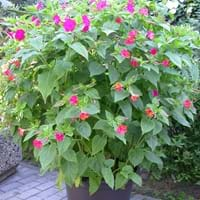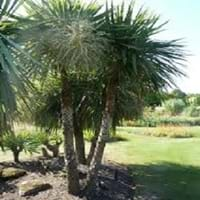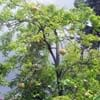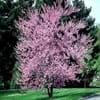Life Span
Perennial
Perennial
Type
Flowering Plants, Grass, Shrubs
Broadleaf Evergreen
Origin
Central America, North America
New Zealand
Types
Not Available
Not Available
Habitat
Temperate Regions, tropical environments
Coastal Regions
USDA Hardiness Zone
7-10
8-11
AHS Heat Zone
Not Available
Not Available
Sunset Zone
Not Available
21,22
Habit
Upright/Erect
Upright/Erect
Flower Color
Pink, Red, White, Yellow
White
Flower Color Modifier
Bicolor
Bicolor
Fruit Color
Black, Green
White, Blue
Leaf Color in Spring
Green, Dark Green
Burgundy, Dark Red, Copper
Leaf Color in Summer
Dark Green
Burgundy, Dark Red, Copper
Leaf Color in Fall
Yellow green
Burgundy, Dark Red, Copper
Leaf Color in Winter
Dark Green
Burgundy, Dark Red, Copper
Leaf Shape
Egg-shaped
Long Narrow
Plant Season
Fall, Late Summer, Mid Summer
Spring, Summer, Fall, Winter
Sunlight
Full Sun
Full Sun, Partial Sun, Partial shade
Type of Soil
Loam, Sand
Loam, Sand
The pH of Soil
Neutral, Slightly Acidic, Slightly Alkaline
Neutral, Alkaline
Soil Drainage
Well drained
Well drained
Bloom Time
Early Fall, Late Summer, Mid Summer
Late Spring, Early Summer, Summer
Tolerances
Drought
Drought, Salt
Where to Plant?
Container, Ground, Pot
Ground
How to Plant?
Seedlings
Stem Planting, Transplanting
Plant Maintenance
Low
Medium
Watering Requirements
Do not water excessively
Average Water Needs
In Summer
Lots of watering
Lots of watering
In Spring
Moderate
Moderate
In Winter
Average Water
Average Water
Soil pH
Neutral, Slightly Acidic, Slightly Alkaline
Neutral, Alkaline
Soil Type
Loam, Sand
Loam, Sand
Soil Drainage Capacity
Well drained
Well drained
Sun Exposure
Full Sun
Full Sun, Partial Sun, Partial shade
Pruning
Cut back old stems to the ground
Prune if you want to improve plant shape, Remove damaged leaves, Remove dead leaves
Fertilizers
as it is a flowering plant, use high phosphorous content fertilizer
All-Purpose Liquid Fertilizer
Pests and Diseases
Aphids, Slugs
Red blotch
Plant Tolerance
Drought
Drought
Flowers
Showy
Insignificant
Flower Petal Number
Single
Single
Foliage Texture
Coarse
Coarse
Foliage Sheen
Matte
Not Available
Attracts
Bees, Butterflies
Caterpillar, Moths
Allergy
Not Available
Asthma
Aesthetic Uses
Showy Purposes, small hedge
Beautification, Landscape Designing, Showy Purposes
Beauty Benefits
Making cosmetics
Not Available
Environmental Uses
Not Available
Air purification
Medicinal Uses
anti-inflammatory, Aphrodisiac, Diuretic, Purgative, Vulnerary
Diabetes, Dysentry, Stomach pain
Part of Plant Used
Flowers, Leaves
Leaves, Root, Stem
Other Uses
Edible dye
Decoration Purposes, Employed in herbal medicine, Showy Purposes, Used As Food, Used as Ornamental plant
Used As Indoor Plant
No
No
Used As Outdoor Plant
Yes
Yes
Garden Design
Container, Edging, Feature Plant, Foundation, Wildflower
Container, Feature Plant, Foundation, Houseplant, Screening, Wind Break, Tropical
Botanical Name
Mirabilis jalapa
CORDYLINE australis 'Red Star'
Common Name
marvel of peru, four o'clock flower
Cabbage Palm
In Hindi
Mirabilis jalapa
गोभी पेड़
In German
Wunderblume
Cabbage tree
In French
Belle-de-nuit
arbre de chou
In Spanish
Dondiego de noche
árbol de la col
In Greek
mirabilis Jalapa
λάχανο δέντρο
In Portuguese
Maravilha
repolho árvore
In Polish
mirabilis Jalapa
kapusta drzewo
In Latin
mirabilis Ja-
brassica ligno
Phylum
Magnoliophyta
Magnoliophyta
Class
Magnoliopsida
Liliopsida
Order
Caryophyllales
Asparagales
Family
Nyctaginaceae
Asparagaceae
Genus
Mirabilis
Acidosasa
Clade
Angiosperms, Core eudicots, Eudicots
Angiosperms, Monocots
Tribe
Not Available
Not Available
Subfamily
Not Available
Lomandroideae
Number of Species
Not Available
Season and Care of Mirabilis Jalapa and Cabbage Tree
Season and care of Mirabilis Jalapa and Cabbage Tree is important to know. While considering everything about Mirabilis Jalapa and Cabbage Tree Care, growing season is an essential factor. Mirabilis Jalapa season is Fall, Late Summer and Mid Summer and Cabbage Tree season is Fall, Late Summer and Mid Summer. The type of soil for Mirabilis Jalapa is Loam, Sand and for Cabbage Tree is Loam, Sand while the PH of soil for Mirabilis Jalapa is Neutral, Slightly Acidic, Slightly Alkaline and for Cabbage Tree is Neutral, Alkaline.
Mirabilis Jalapa and Cabbage Tree Physical Information
Mirabilis Jalapa and Cabbage Tree physical information is very important for comparison. Mirabilis Jalapa height is 60.00 cm and width 50.00 cm whereas Cabbage Tree height is 610.00 cm and width 240.00 cm. The color specification of Mirabilis Jalapa and Cabbage Tree are as follows:
Mirabilis Jalapa flower color: Pink, Red, White and Yellow
Mirabilis Jalapa leaf color: Green, Dark Green
Cabbage Tree flower color: White
- Cabbage Tree leaf color: Burgundy, Dark Red and Copper
Care of Mirabilis Jalapa and Cabbage Tree
Care of Mirabilis Jalapa and Cabbage Tree include pruning, fertilizers, watering etc. Mirabilis Jalapa pruning is done Cut back old stems to the ground and Cabbage Tree pruning is done Prune if you want to improve plant shape, Remove damaged leaves and Remove dead leaves. In summer Mirabilis Jalapa needs Lots of watering and in winter, it needs Average Water. Whereas, in summer Cabbage Tree needs Lots of watering and in winter, it needs Average Water.





